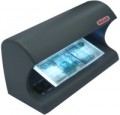Means for authenticity check of counterfeiting or damaged bills, provided in the design of the detector.
—
Ultraviolet(UV). Detection based on the illumination of bills with ultraviolet light. Many modern currencies have protective elements in their design that glow under such light. Also, with UV light inscriptions made with special varieties of “invisible ink” become visible (for example, the inscription “Bribe” on bills used as evidence in a criminal case). Due to its simplicity (only a UV lamp is required for operation), this type of detection is very popular and is found even in inexpensive devices.
—
Infrared(IR). Detection using infrared light. It is similar in application to ultraviolet (see above), except that a special camera and display are needed to view bills in IR light. Therefore, detectors with this function are usually not cheap.
—
By size. An authenticity check that involves determining the size of a bills. It can be used both to check for authenticity and to detect foreign bills in a stack of bills of the same denomination, as well as to search for torn, folded in half, worn out money. Usually, such check is effective only if there are noticeable differences between suspicious bills and the regular.
—
By magnetic marks. Authenticity check based on the reading of magnetic marks
.... Such tags are used in many modern currencies (in particular, US dollars and euros), mainly in the form of a special paint that is “noticeable” for magnetic sensors.
— By optical density. Detection based on optical density — the ability of a bills to transmit and retain light. It is mainly used in automatic detectors (see "Product Type") to detect sticky bills: the device reacts to a significant excess of optical density.
— Check in white transmitted light. Verification based on translucence of the bills with white visible light. Usually, such translucence is used to develop watermarks, security stripes and other similar elements, as well as to assess how the image on different sides of the bill correlates.
— Check in white reflected light. A check based on the analysis of the reflection of white light on the surface of the bill. Illumination with bright white light allows you to identify some security features (eg holograms), as well as evaluate the quality of printing security, print clarity, security fibers, etc.
— Ink spectral analysis. Spectral analysis of the ink that was used to apply the pattern allows you to determine its chemical composition based on the characteristics of the reflected light. In this way, you can detect a counterfeit even if all other security elements are indistinguishable from the original ones.
— Special element "M" verification. The special element "M" is a label that is clearly visible in infrared light only when illuminated with infrared light of a certain wavelength. The detection of this element is carried out due to the fact that the detector alternately illuminates the bills with IR rays with different wavelengths, due to which the effect of the label “flickering” occurs on the detector screen.
— Anti-stokes verification. The special element "I" (also known as "anti-stokes") is applied using a special composition, which begins to glow, under the intense infrared light of a certain range. At the same time, unlike the special element “M” described above, this glow can be seen with the naked eye; it may have different colours.The total power consumed by the counterfeit detector during operation. In most cases, this parameter is purely reference. Even the most powerful modern counterfeit detectors consume about 50 – 60 W — this is not enough to overload the network or significantly increase power consumption. However, there are situations where power data can be useful, such as when calculating the load on an uninterruptible power supply.

